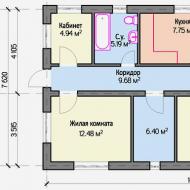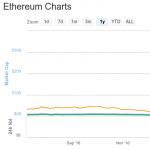
Prospects for the development of the global monetary and financial system. Prospects for the development of international monetary and financial relations The World Financial System of Development Problems
The World Financial System is economic relations related to the functioning of world money and serving various types of economic relations between countries (foreign trade, capital export, investing, the provision of loans and subsidies, scientific and technical exchange, tourism, public and private transfers, etc. ).
The relevance of the topic of research determines what modern conditions Deepening the integration of economies of industrial-developed countries The World Monetary System plays an increasingly important and independent role in world-economic relations. In addition, factors have a direct impact on the economic position of the country: the growth rate of production and international exchange, prices, wages, etc.
The purpose of the study is to study the development trends of global financial in the 21st century.
The trends in the development of the global financial system include the following.
Regulation of financial markets and investment institutions, namely:
1) Strengthening the financial system and reforming local financial institutions through the development and dissemination of international principles and standards of regulation and supervision of the banking system, stock market and various financial institutions.
2) defining ways to strengthen prudential supervision in both developing and developed countries;
3) the creation of mechanisms for market regulation of the derivatives market and investment activity with the active use of borrowed resources;
4) Introduction Stimulation international standards Activities in offshore financial centers.
Established economic policy:
1) determining the conditions for the liberalization of the domestic market and the introduction of an adequate currency regime in countries with emerging markets, the development of methods for monitoring the movement of international capital;
2) improving the effectiveness of the mechanisms of state support for the private sector and the distribution of social benefits;
3) search for ways to minimize population loss as a result of crises and policy development, which would better protect the most vulnerable segments of the population;
4) expansion of transparency in the private and public sector and in the activities of international financial institutions.
Creating new international structures:
1) to create a separate proper institute or to give new powers of one of the existing international organizations to coordinate the directions of the macroeconomic policy of leading and developing countries, especially in the provision of inflation and employment;
2) Create a system of international financial regulation to develop uniform international standards and oversight of the activities of institutes conducting operations globally. An important step in this direction could be regular meetings of representatives of the financial authorities of G-7 countries, leading countries with emerging markets and international financial organizations in the framework of the Special Forum on the Regulation Policy.
The objectives of improving the global financial system at the present stage are:
1) restoration of economic activity and investor confidence in countries who survived the financial crisis;
2) preventing further dissemination of the crisis on developed countries;
3) minimizing the risks of future crises, limiting their depth and scope;
4) restricting the financial costs of output from crises and reduce time on their overcoming;
5) restriction of possible loss of investors in the course of future crises;
6) creating a financial system that would use all the advantages of global markets and capital mobility at the minimum risk of destruction and effective protection of the most vulnerable social groups of the population;
7) enhancing the surveillance of the IMF for policies conducted by participating countries, especially in the financial sector and in the field of capital movement;
8) improving the effectiveness of macroeconomic policies at the interethnic level.
Thus, the development and stable operation of the international financial system is due to the growth of productive forces, the creation of the global market, the deepening of the international division of labor, the formation of the global system of the economy, the internationalization of economic relations.
Literature:
1. Noscova I.Ya. International financial and credit relations: studies. benefit. - M.: Uniti, 2010.-346 p.
2. Fedorov B.G. Modern currency credit markets. - M.: Finance and Statistics, 2008. - 345 p.
In the modern Russian economy there is a transition to a qualitative new state of the financial system, characterized by the ability to implement its fundamental function - financing economic growth. At the same time, the Russian financial system does not cope with the need to organize the redistribution of financial resources and their transformation into a real economy, its level of development does not comply with the requirements of modern economic growth. Russia objectively needs a system of measures to accelerate the development of the financial system, financial markets, financial and intermediary sector, i.e. in creating adequate financial support for economic development.
The large-scale change in the qualities of financial capital, expressed in the emergence of new forms of financial and economic relations with a global plan, most of all affected the financial space and relations arising between the practice of functioning global finance and policies aimed at ensuring the integrated development of a country corresponding to the mainstream trends in the world from the standpoint Financing of public life.
The result of financing was the sharply increased share of the financial sector in the global GDP, prevailing in the economies of developed countries of revenues from operations in financial markets that took the main place in the structure cumulative revenues societies. In the public consciousness of developed countries, a new model of behavior focused on the dominance of financial services and financial instruments that organize the movement of financial (monetary) resources are approved.
Under the influence of global corporate capital (GKK), the vector of development of the financial system of Russia, its elements are adapted (not always organically) to new financial forms. First of all, the components of the system-forming finance subsystem are becoming homogeneous, including state finances, corporate capital of natural monopolies, and under the influence of financial globalization - finances representing the GKK.
Significant changes in the overall economic situation and the country entailed the deficit of financial resources necessary to change the structure of production, ensuring infrastructure transformations and the effective organization of capital markets, financial and economic complexes and individual industries.
In fact, the real sector of the economy turned out to be the hostage of the previsors among the reformers of the championship of macroeconomic achievements before institutional and structural reforms. The fallacy of this position is repeatedly proven by modern realities. Deep structural transformations in the economy and institutional reforms become a condition of not only macroeconomic stability, but also the transition to a qualitatively new stage in Russia's development.
Under the financial development of the country, it is necessary to understand relations on the equivalent access of economic entities to sources of financing their entrepreneurial activity. These will be banks or other financial institutions - no significant role plays. The economy needs to develop not one part of the financial system, and all its elements and, most importantly, in ensuring financing long-term investment programs.
There was a geographical compression of the global economic space, requiring new forms of relationships. As part of the study of the economic space, a separate consideration deserve financial space and relationships that may arise between policies aimed at ensuring the self-deviating development of the country and the dominant financial and credit world-economic complexes. Study of these relations of the geoeconomic approach
N.P. Obukhov calls Geofernans.
The concept of geoeconomics is often used without proper understanding. In our opinion, this concept reflects the production of financial resources, their sufficiency to finance global economic processes, and Geofinans give them directed movement in the extension space. Therefore, the prefix of geo- in both cases indicates the character of financial and economic processes globally. These two concepts are composite parts of a more general concept - globalization. From this, both terms can be replaced by the concept of financial globalization, under which we are understood as the process of formation and subsequent development of a single global financial and economic space based on new, mainly information technologies. This concept chain is presented in Fig. one.
As already noted in Chapter 1, the realization of financial globalization processes in the global economy is the global financial market.
By its economic essence, the Global Financial Market is a system of monetary relations that performs the redistribution of global financial resources between economic agents, sectors of the economy, countries and regions of the world. From an institutional point of view, the global financial market can be viewed as a system of financial and credit institutions and regulatory bodies providing a circuit of financial resources in the global economy by creating international chains "Investor - Borrower". From a functional point of view, the global financial market is a set of market segments that ensure accumulation and redistribution of funds between the enterprises of the global economy through financial institutions for the purposes of reproduction and achieve the normal relationship between supply and capital supply.
The formation of the global financial market began to be felt in the early 60s of the twentieth century. And it happened on the basis of the internationalization of international operations of national loan capital markets. Up to this point, due to a number of historical reasons - the global economic crisis of 1929-1933, the Second World War, which existed currency restrictions, tight market regulation - the financial market was practically paralyzed.
Currently, integration processes in the global financial market actually form unified system interest rates and contribute to the narrowing of the circle of currencies applying to it. There is a transformation of leading national companies and banks into transnational. It is they who, in view of the need to obtain additional profits, contribute to the fact that free assets are invested in industrial and financial structures abroad, and if necessary, additional capital is borrowed in the world market. Thus, there is a significant impact on the development of operations related to the movement of capital, and sometimes on the state of individual national economies. It should be noted that the processes of development of the global financial market, on the one hand, lead to the rapprochement and association of individual markets, and on the other hand, the desire for their isolation in order to protect national economies from the harmful influence of the processes related to the free movement of capital. In modern conditions, the desire for the isolation of national economies conflict with the process of internationalization of the world economy and does not bring the desired results.
An important condition for the functioning of the global economy is freedom in the field of capital movement in the world market. In this regard, throughout the post-war period, the policy of gradual removal of foreign trade and currency restrictions was carried out. The form and degree of state intervention in the operations in the financial markets changed depending on the currency position of individual countries and the state of their economy. Gradually, as a result of internationalization, the world economy takes a qualitatively new content, a global integrated financial market is formed, inside which there is a constant mutual flow of capital, short-term investments are transformed into secondary and long-term loans, the issuance of securities replaces regular bank loans. The total amount of securities in the world is currently calculated by astronomical indicators. Thus, there is a tendency of the exclusive pace of development of the global financial market, both in general and its individual elements.
The global financial market includes various types of markets:
outdoor unregulated currency markets that unite financial institutions of different countries. Bidding them are carried out by electronic transfers through global computer networks;
bonds exchange and over-the-counter markets that allow foreign issuers to let their valuable debt securities in large national markets. Financial centers of these markets are countries such as USA, United Kingdom, Japan, Germany, Switzerland and Luxembourg;
the market of syndicated Eurocredits allows international borrowers to carry out funding in the form of bank loans from several countries. Financial centers are London, Frankfurt, Zurich, New York, Hong Kong, Singapore, etc.;
eurobond and European commercial and other debt securities markets. International borrowers have access to credit resources of investment funds, hedgefonds, mutual funds, pension funds, insurance companies, treasury departments of large corporations, private banks of other countries;
the markets of derivatives that ensure the movement of financial capital through national borders and making transactions between economic agents residents of various states.
At the same time, the global financial market is a system of interrelated markets: money on which operations with debt instruments are taken from 1 day to 1 year; credit serving the provision of loans for a longer period; securities (emission and purchase and sale of the latter).
Among the main trends of the global financial market can be allocated:
A higher diversification.
International investors and borrowers are worth today in front of a huge selection between markets, financial products, currencies, risks, etc. Active participants in the global financial market receive an additional overview of markets, products, capital flows and a competitive situation. The global competition of competition also forces the rate of introducing innovation, usually higher than that in the market, protected by national protectionist policies.
Higher liquidity.
Due to the large number of participants, the financial products of the global financial market are characterized in most cases improved liquidity. This is primarily applied to officially organized financial markets.
Increased attention to the risk management process.
Globalization, information technology, financial innovations and modern theories for the management of assets portfolio allowed for a short time to work out a special system of risk management and their optimization: risks are divided, evaluated, are reinstalized, eliminated and limited. Thus, the risk losses with which the company inevitably faces, operating in a global financial environment, minimized.
It is known that transnational corporations in the process of their activities operating in the global environment are often faced with various types of financial risks. One of these methods is hedging with financial instruments.
Chart 2.1. The volumes of the derivatives market in trillion. dollars in 1998-2007 Source: Ershov M. Crisis 2008: "The moment of truth" for the global economy and new opportunities for Russia. - Economy issues №12, 2008
More efficient capital distribution.
Globalization and information technology brought the possibility of a more efficient distribution of investment capital, at least in the medium term.
In essence, globalization encourages mutual mutual understanding from the investor and the borrower.
Strengthening crisis phenomena
Existing information flows available simultaneously for all can lead to global processes characterized by excessive reactions and sharp change of moods. All this helps to strengthen the negative effects of crises, and as a result, the difficulty of exiting them. Losses from financial crises also become larger.

Diagram 2.2. Losses of countries from financial crises (billion dollars) Source: ibid.
Specs global participants in regional markets.
Globalization of financial markets often leads to the difference between global and domestic market-oriented by participants. Thus, regional or national capital markets that are important for capable of being quoted small and medium-sized enterprises can be used to obtain margin. At the same time, it is small and middle stock exchanges that are supposed to contribute to building its competitiveness as members of integrated global markets. In this process, globalization can have a positive effect on pure domestic markets if not revolutionary measures, then at least evolutionary.
Growth of international competition.
As a result, markets are becoming more effective, many limitations and barriers are removed, a market balance is established. On the other hand, growing competition significantly improves the requirements for financial institutions and corporations in terms of their economic efficiencyAs well as to governments in terms of improving the investment climate, ensuring the political and economic stability of national economies who are forced to compete with each other for credit resources on the scale of world economy.
8. Growth of the informational and analytical component.
Large banks organize powerful information structures connecting customers with financial, investment and commodity markets. At the same time use all possible channels for obtaining information. Owning information, banks provide a wide range of consulting services, provide data on the market status and enterprises operating on it. Moreover, they unfold active consulting in the field of internal and external management of their customers - predetermining their economic policies and internal structure.
It is believed that the last 30 years the market is developing towards the fact that he was about 90 years ago. And the main difference between globalization then is now in the nature of the capital, which serves trade and investment flows.
On the one hand, its significant part is criminal cash, i.e. Those used to finance the shadow economy, organized criminal groups and the corrupt part of the state apparatus. According to the UN statistics in the international financial system, approximately $ 300 million is legal every day. Annual drug business trafficking ($ 400 billion) is the third in terms of oil and weapon trade. Source: Moiseev S. R. Globalization of financial markets: Myth or reality? Digest Finance - №3, 2002.
On the other hand, with the admission of an increasing number of countries to market system Economy Most of them become recipients mainly speculative capital. As a result, they suffer because of a sharp inconsistency of the speed of its movement and the timing of the creation of traditional, material technologies on which they specialize. Large-scale attachments of speculative capital, which are encouraged by the policies of governments focused on premature liberalization of financial transactions, are ineffective for states with underdeveloped economic structure and export base. Capital leaves, did not have time to create anything real and leaving some destruction after himself.
The opposite view of globalization is expressed in the circles of American financiers who believe that the world lives in a period similar to the period of the industrial revolution. Only today we are talking about computers and telecommunications, about the revolution in technologies that increases productivity, economic growth, contributes to the global financial and technological integration, under the influence of which competition increases and the pricing mechanism is destroyed in corporations, which restrains inflation. And when inflation is under control, the possibility of increasing the living standards of people is increasing.
The development of the American economy over the past decade confirms this optimism. And although many economists doubt that the revival of productivity growth in the American economy will continue, and fear that it is caused by a speculative boom, as it was already in the mid-80s in the Great Britain economy, and a little later - Japan, deny the leading position of the United States in creating and distributing High information technologies and the role of these technologies in strengthening the dependence of various financial markets between themselves and all together from the economic and financial influence of the United States.
Pioneers for the development of these technologies - USA - attract the most mobile form of financial capital - speculative capital. The short period of its appeal corresponds to the rate of development of information technology and wears a production nature for their recipient.
Therefore, globalization as a reflection of the strengthening of the American influence in the world and their desire to ensure the information transparency of all countries through the application of standard methods of statistics, accounting, reporting, audit, trade techniques of commercial and financial operations, as well as adequate for analysis and forecasting methods of macroeconomic regulation - convincing reality .
In modern conditions, it is not interesting to pay attention to the trends in the development of the global financial market and its main indicators under the crisis.
What is happening today in the United States and in the global economy as a whole - not "ordinary" recession, but a combination of extraordinarily large-scale "delegation" (deleveraging - a reduction in debt load) and deflation related to a sharp reduction in liquidity due to termination of lending to all of all. Such processes occur less often than recessions - only examples of the "Great Depression" in the United States, the Latin American debt crisis of the 1980s and Japan of the 1990s can be cited. The slowdown in the volume of lending in Russia is presented below.

Chart 2.3. Slowdown in the growth of loans to the population and enterprises (in% of the previous month)
- Introduction
- conclusions
- Sources
Introduction
The topic of testing "The evolution of the global monetary and financial system is the possibility of transfer systems and prospects for their development" on the discipline "Finance".
The goal of the work is to reflect the stages of the evolution of the global monetary and financial system regarding the change in the transfer capabilities of its subjects, depending on the availability of resource and communication conditions for transactions, obtaining financial resources and information on the financial market conjuncture and the like.
The evolution of the global monetary and financial system - the possibility of transfer systems and prospects for their development
The evolution of world currency and financial systems is fully investigated in terms of transition from the lowest form to the highest, methods of operation, the conditions of their application. Traditionally, it was believed that at each stage of evolution due to the deterioration of the situation with international liquidity, a new currency and financial system was created, which was supposed to resolve this problem. The concept of "international liquidity" is inextricably linked with such factors as the gold and foreign exchange stocks of central banks and the possibilities of countries regarding gold mining. Despite the fact that since the 70s of the XX century. Gold no longer performed the function of money, scientists tend to explain even the current state of the global monetary and financial system, taking into account the dynamics of gold mining, changes market value and demand for him from the central banks. For such an opinion there are objective reasons.
First, an indisputable fact is that the Gold Standard system has always, whether it has been gold, gold and gold and gold, functioning perfectly due to the solid binding of currency emissions to the gold reserves of central banks. But natural restrictions, complex economic and political relations between states, catastrophic events in international life (the first and second world wars) led to the fact that the dynamics of world trade began exceeding the dynamics of gold mining, that is, the emergence of international illicitality was due to its global markets .
Secondly, the key to the success of the Bretton Woodd currency system was that when it was created (1944 rubles), more than 70% of world gold reserves were concentrated in the Fed. This allowed the states to turn the dollar into world currency by issuing emissions on such a scale that the international trade and interests of the national economy were required. It would seem that Bretton Wood provided unrealistic guarantees, based on, in particular, not only to the mentioned binding, but also on the activities of the UN specialized organizations, namely the International Monetary Fund, the International Bank for Reconstruction and Development. International Financial Cooperation, International Development Association, International Investment Guarantee Agency. But the problem of international liquidity gradually agreed and sooner or later was to loudly declare himself. Significantly accelerated the events in this area short-sighted economic policy of the United States. In the late 60s - early 70s, most countries participating in the IMF officially recognized that the current global financial system was based on the binding of gold to the dollar, exhausted itself and cannot guarantee stability for financial markets nor promote the development of the world farms.
Thirdly, although one of the key postulates of the Jamaican Conference (1976) was a refusal of gold as a universal equivalent and from the use of convertible currencies as a reserve, until now, the gold currency reserves of central banks along with the latter include collective currencies, 25% of the country's share In the IMF, as well as banking metals (gold, silver, platinum and palladium). It should be paid to the fact that in recent years, the demand for gold is constantly growing in the banking metals market (2000 - 255 dollars, 2005 - 450, 2009 - 1214, 2010 - 1350 dollars.) . The first rating company recently published data on the owners of the greatest gold reserve. According to this information, the United States belongs to 8965.6 tons of gold, Germany - 3767,1, IMF - 3546,1, France - 2930.4, Italy - 2702.6, Switzerland - 1285.6, Japan - 843.5, Netherlands - 688.39, the European Central Bank - 666.5 tons. The gold stock of Ukraine is 26.8 tons, only 2.7% of official gold and foreign exchange reserves of the NBU are formed in gold, we occupy the 50th place in the ranking.
Outside the field of view of the researchers, the transfer capabilities of the subjects of the global monetary and financial system were left as determining the factor of their evolution, as well as the impact on these possibilities of innovative solutions. The concept of "transfer capabilities" includes the availability of resource and communication conditions for transactions, as well as obtaining financial resources and information from other subjects of the system. These features are characterized by certain qualitative parameters, primarily the speed, safety, multichannel of transaction, and are linearly connected with several prerequisites:
the presence of international and national guarantees of the safety of transactions;
development of communications;
the flexibility of the mechanisms for collective accumulation of resources with various financial instruments and their use in those directions that have the greatest profitability potential;
diversification of methods and sources of public informing about the status and prospects of financial markets.
Analysis of the development of the global monetary system shows that the emergence of international illicitality is usually accompanied by a decrease in the transfer capabilities of its subjects, with all the characteristic features of this process: the transaction is slowed down, the number of channels of attracting and transmitting resources to business partners decreases, security guarantees are reduced. Thus, since 1914, European countries began to gradually carry out the issuance of national currencies without binding to the gold reserves of their central banks, and in the global financial transaction market were carried out only in convertible currencies. Until 1937, almost all countries refused the Golden Standard. At first, transfer capabilities were reduced due to slowing down transactions and reduce the number of channels to obtain and transmit resources to business partners, and then when alternatives in the selection of currencies finally disappeared, the main problem was an extremely low level of security of any transaction.
In this case, under innovative, we understand the heads of government and central banks adopted by the heads of government and central banks at international conferences, as well as at meetings of international financial organizations, the implementation of which fundamentally changed the "Rules of the game" and provided new opportunities for the subjects of the global monetary and financial system.
There was an indicative of the decrease in transfer capabilities as a result of the emergence of currency blocks. As is known, the currency unit is a grouping of countries dependent in economic, financial and other relations from a strong "hegemon" dictating them foreign Policy and using them as a privileged sales market, the source of cheap raw materials, a profitable investment sphere of capital investments. The idea of \u200b\u200bcurrency blocks itself was interesting and quite promising. But during the creation of these blocks, there were no prerequisites for their effective functioning: we are talking about the absence of the 1930s of the XX century. Global and even regional communication and information networks, as well as an adequate mechanism for establishing floating courses of non-convertible currencies relative to currency of economically developed countries. The system of currency blocks, without having the opportunity to solve the main problem - to increase the level of international liquidity, was actually applied partially, existing in full only "on paper", and to a certain extent contributed to the deepening of the payment crisis on the eve of World War II.
There were also signs of reducing the transfer capabilities of the subjects of the global monetary and financial system during the functioning of Bretton Woods agreements. Thus, since the creation of the IMF, there were constantly failures in this area related to the negative balance of payments of its participants, in particular those who owned non-convertible currencies. The transfer capabilities of this category of participants were limited, for they, as a rule, did not have export potential, did not affect the IMF policies and actually depended on the subsidies from economically developed countries. At the turn of the 60-70s, the indicated decline has acquired a global scale. The leaders of governments and central banks of many countries expressed doubts about the then dollar rate and its security of the US balance of payments. The causes of the unfavorable were as follows:
1. After World War II, the Eurodollara market was formed. Western European countries were interested in their high cost, since the dollar was used as a reserve currency.
2. To stimulate the development of export potential and align their payment balances, Western European countries led to the devaluation policy than the dollar has overestimated.
3. USA, implementing policies free market, refused to introduce quotas for importing products from Europe and deliberately allowed the transformation of the positive balance of the balance of payments to the negative one.
4. The predominant part of the imported products of the United States was calculated by debt treasury commitments.
As a result, the rapid development of the global economy and the growth of world trade demanded an additional tributary of dollars to financial markets. Responding to this need traditionally - emissions was impossible due to the binding of the dollar to gold; Of course, the increase in the mass of dollars required to replenish the stock of gold, and it was unrealistic.
So, the transfer capabilities of the constituent entities of the global financial market were reduced, because in circulation lacked dollars. In addition, there was a danger of their impairment if the US Federal Reserve still launched a printed machine, despite the agreements 1944.
In the post-war period, the security problem in international financial markets was extremely acute. In the US, Europe and Asia, almost simultaneously developed and implemented measures aimed at eliminating abuses in the banking sector, the emergence of which contributed to the lack of a mechanism for monitoring market participants. Cooperation of the Bank of International Claims with central banks Developed countries had their result the signing of Basel Concordat (1975), which laid the basics of security in banking, which so far. In the document, we are talking about the unification of banking terms, the introduction of standards for the level of financial sustainability, as well as the reporting of banks engaged in international transactions, in front of central banks.
With regard to changing the transfer capabilities of the subjects of the global financial market, the Jamaican system is most ambiguous. This is due to two factors:
the introduction of floating exchange rates corresponding to demand and suggestions;
the world network of cable and satellite communications SWIFT (SOCIETY FOR WORLDWIDE INTERBANK FINANCIAL TELECOMMUNICATION - Society of World Interbank Financial Telecommunications) was deployed.
Both factors eliminated any restrictions on the growth of global trade, ensured the quality of the transfer capabilities of market entities, since SWIFT works on NATO logistics, covering all time zones and supporting about 100 data formats. However, on the other hand, due to the lack of binding of courses and emissions to the gold wanders of central banks, the control mechanism was lost, which led to a unreasonable increase in dollar masses in the world. The famous analyst Chris Hedgees argues that from the beginning of the XXI Art. The United States increased the amount of money in circulation at a speed of 2 billion dollars. in a day. In general, the increase in the turnover in the foreign exchange markets is generally explained by the communication capabilities of the SWIFT network: using it, transnational banks easily carried out transactions between their foreign offices located in different time zones, and due to this they received speculative profits due to the course difference at the beginning and end of the working day. Fund markets began to grow unprecedented pace, in particular the derivatives market. So there was a speculative capital, a significant part of which is a fictitious (virtual), and the volume significantly exceeds the cost of global GDP. Let us give an example: the turnover of the market of derivatives on gold in Chicago and New York is about 99% of the real gold market in London and Zurich. Moved under the influence of a situational difference in demand and suggestion on communication channels from one market to another, this speculative capital creates a danger of the crisis of non-payment and collapse of currency and stock markets. It was so far that developed countries, having large investment resources and branched communications, are able to influence the conjuncture of financial markets and thereby getting certain benefits from the take-off price of assets or, on the contrary, from their fall. Developing countries traditionally resort to currency restrictions to protect the national currency, and do not allow the threatening inflow of foreign capital, which significantly limit the transfer capabilities of local subjects of monetary and financial relations. The problem of planetary scale was also a catastrophic growth of debts of many countries (Greece, Portugal, Ireland).
The scientific and entrepreneurial circles are actively discussed by ways to avoid dangers that carry a modern world monetary and financial system.
The following suggestions are considered constructive:
world Financial Currency Transaction
1) ensuring control over foreign exchange markets, withdrawing overweight of money from circulation;
2) maintaining opportunities for the rapid, safe and multivariate implementation of international transactions;
3) the transition to the multipolar structure of the global monetary and financial system.
When analysts talk about the withdrawal of excessive mass of money from circulation on a global scale, it is definitely meant above all the dollar. If we take into account the volumes of dollars that are in the reserves of central banks of different countries, it becomes obvious: it requires a joint participation of the main financial poles to ensure stability in global financial markets. First of all, participation would have to be supposed to prevent sharp fluctuations in the dollar. This can be achieved by entering the currency corridor system for all leading currencies of the world (dollar, euro, English pound sterling, yen, etc.). An important measure in establishing multipolarity of the global monetary system is an expansion of the list and balancing the shares of currencies in a basket of special borrowing rights (SPZ) 10; To accomplish such a task, it would be necessary to change the method of calculating these shares, in particular, consider the regional factor, choosing currencies for the basket.
Create corridors for leading currencies in the world in order to withdraw an excessive mass of dollars from circulation. No fundamental changes in the derivatives market. On the one hand, thanks to this market, financial resources are rapidly accumulated and speculative profits are growing, therefore, new companies arise, competition between investors is exacerbated, risks are diversified when financing large long-term investment projects; But, on the other hand, the instability of the derivatives market is the main reason for payment crises in the field of lending. As you know, before the events of 2007-2008. Ukrainian banks received solid amounts of funds from abroad. Foreign investors, widely promoting in various media promising forecasts about the rate of development of new Ukrainian and other markets, made it all so that the market value of derivative securities increased several times against the initial. But as soon as the first signs of the crisis appeared and earned the mechanism of "Payments on Accounts", it turned out that radiant forecasts are overestimated, that is, actual income is much less than the expected. This was the reason for the bankruptcy of newly created investment funds, reducing the ratings of companies receiving loans secured by derivatives, deterioration in the structure and profitability of loan portfolios of multinational banks, bringing to the crisis state of Ukrainian financial institutionsWhere foreign capital was seized.
Special Borrowing Rights (English Special Drawing Rights, SDR, SDRS) - a backup payment agent, the emission of which is carried out by the IMF and which exists only in non-cash form in the form of records in bank accounts. The cost of SPZ is calculated on the basis of leading currencies. For the first time, SPZ was used in 1969 to solve the problem of international illicitality. During 2006-2009 The share of the dollar in the SPZ basket was 44%, Euro - 34, yen and pound sterling - 11%.
Due to the above regulation of markets for derived securities should be significantly updated. In particular, it is necessary to adopt restrictive measures to change the market value of derivatives, as well as apply clear mechanisms for its binding to the value of assets based on derivatives. Such measures would have a positive effect on the stability of the global monetary and financial system and national financial markets that are in the formation stage, including the stock market of Ukraine.
In general, the most applied currency and financial systems is most appropriate for economic development and financial stability Ukraine System of currency blocks. Today it has all the prerequisites for its operation. We list them. First, there are various backup currencies that can be mutually replaced by each other to a certain extent. Secondly, global communication networks operate, with the help of which the relationship between all regions and currency zones is associated. Thirdly, the division of foreign currency and peripherals, which is envisaged by the concept of "currency block" itself, and it is advisable in the context of multipolarity of the global monetary system. This division could serve as a real basis for issuing central currencies in volumes corresponding to the needs of a zone. Such an order would allow us to weaken the negative impact of the dollar on the economy of Ukraine, deepen the diversification of currencies on export and import contracts, bring the conditions for the development of the national financial system to the system of the country in which it would be part of the currency zone. True, it is necessary to admit that intergovernmental agreements are required here, which would guarantee the prevention of actions aimed at reducing the transfer capabilities of the subjects of monetary and financial markets.
The currency block system can provide listed positive effects only if it covers all countries and regions. This is the key to stability in global currency markets. If it is distributed only to a separate region or a certain group of countries, the confrontation between the leading currencies will increase.
conclusions
Summarizing the said, we emphasize that we believe it is necessary to make changes in the global monetary and financial system in those periods when the transfer capabilities of its subjects are reduced. The decisions of representative international conferences are aimed at their increase, as well as permanent specialized organizations. These decisions can be divided into three groups: effective, ineffective and those that play twofold role. The first group includes decisions on the introduction of the golden standard, the Bretton Woods currency system, the creation of a compensatory funding fund, about collective currency (special borrowing rights) and the signing of Basel concordate. The second group includes decisions on the transition to gold and gold-based systems, creating currency blocks. The third group makes decisions about the Jamaican currency system and SWIFT network.
The paper reflects the stages of the evolution of the global monetary and financial system regarding the change in the transfer capabilities of its subjects, depending on the availability of resource and communication conditions for transactions, obtaining financial resources and information on the conjuncture of the financial market and the like.
Sources
1. Owners of the largest gold reserve (http://www.ratel.com.ua).
2. Features of international investment activities in the gold markets (HUP: // www.blog. Liga.net).
3. Currency blocks and zones (http://buklib.net).
4. Currency blocks (http: // dic. Academic.ru).
5. Fundamentals of international monetary and financial and credit relations. Textbook. - M., Infra-M, 1998, 432 p.
6. CIS - Analytical Articles (http: // vvww. SND-SU. IU).
7. http://www.epravda.com.ua.
8. GOLD FIELD MINERAL SERVICES LIMITED (http://www.inlomine.com).
Similar documents
The concept of the international currency system, elements, history of development. Effect of European currency on the transformation of the global monetary and financial system. The current state of the economies of various countries in the world in the context of the crisis of the global monetary and financial system.
course work, added 01.05.2013
Currency and financial conditions of foreign trade contracts. Basic principles and stages of the development of the global monetary and financial system. Essence and types of international calculations. The concept of the form of calculations in foreign trade, the assessment of the merits, disadvantages of various methods.
examination, added 03/17/2010
Currency course and factors affecting its formation. The theory of currency regulation theory. The evolution of the global monetary system as a factor in the development of international monetary and financial relations. Currency and financial conditions of foreign economic transactions.
abstract, added 09/16/2014
The evolution of the development of the global monetary system, the features of the interaction of its main participants, the place in it of Russia. Global imbalances and reforms of the global monetary and financial system, the role of the International Monetary Fund. Principles of capital movement.
course work, added 01.07.2014
The main concepts and role of the global financial system, the features of its structure. The role of world finances in the global financial system. Sources of financial resources for international business. Types of financial resources. Analysis of the problems of the global financial environment.
course work, added 14.10.2014
coursework, added 02/16/2011
The concept and genesis of the global monetary system. Advantages and disadvantages of the Gold Standard system. The preconditions and stages of creating the European Union. International monetary and financial institutions. Payment conditions for foreign trade contracts.
presentation, added 04/28/2015
The concept of currency and exchange rate. The essence and main stages of the evolution of the global monetary system. Characteristics of the main forms of international calculations. The process of buying and selling foreign currency. Institutional structures and the functions of the foreign exchange market.
abstract, added 18.10.2014
abstract, added 11/29/2014
Essence, stages and patterns of development of international monetary and financial relations, their subjects and objects. Characteristics of foreign exchange operations in Ukraine, instruments of their regulation. The main problems and prospects for the development of the currency system in Ukraine.
















